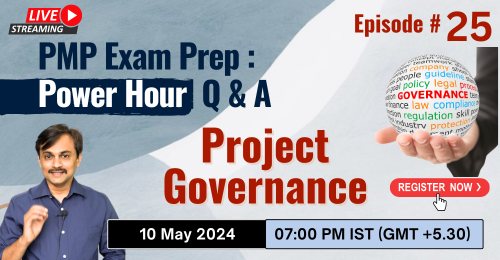Business Environment – Project Governance and Life Cycles
Understanding the symbiotic relationship between governance systems and project life cycles is crucial for PMP candidates as they shape project execution and alignment with organizational goals. Governance frameworks provide the necessary oversight and strategic guidance throughout a project’s lifecycle, whether it’s predictive or adaptive.
Predictive Life Cycles and Governance
Predictive projects operate under clearly defined phases, with governance serving as the checkpoint at the end of each phase. This traditional approach entails meticulous planning and disciplined execution, with phase gates to assess project health and viability, ensuring that the project aligns with the defined scope, schedule, and cost baselines. Governance here typically encompasses:
- Budget and Finance Management: Oversight of budget allocation and financial controls.
- Project Baseline Approval: Establishing and approving project baselines for scope, schedule, and cost.
- Variance Tracking: Monitoring project performance against the baselines.
- Deliverable Reviews: Evaluation of deliverables at designated milestones.
- Change Control and Budget Adjustments: Managing changes and aligning budget adjustments with governance policies.
- Issue and Risk Management: Handling issues and risks within the framework of established procedures.
- Process Compliance/Audits: Ensuring adherence to organizational processes and conducting audits.
Adaptive Life Cycles and Governance
Adaptive life cycles, particularly Agile, integrate governance within iterative processes. The focus is on iterative learning and accommodating customer feedback over a strict adherence to initial plans. Governance in adaptive projects is outcome-focused, with iterative reviews ensuring alignment with customer expectations. Typical key aspects include:
- Iterative Deliverable Reviews: Assessing deliverables at the end of each iteration.
- Backlog Refinement Guidance: Guiding the prioritization and refinement of the project backlog.
- Release Planning and Tracking: Planning and monitoring release schedules.
- Issue Management and Impediment Removal: Facilitating issue resolution and removing blockers to project execution.
- Business/Strategic Alignment: Ensuring the project remains aligned with business strategies and objectives.
- Compliance Audits: Verifying process adherence and regulatory compliance.
Tailoring Governance to the Project’s Needs
It is essential to tailor governance to the specific needs of a project, considering its complexity, strategic importance, and oversight requirements. PMP candidates should be adept at selecting the right governance structure, modifying it as necessary, and ensuring that every project activity is governed with precision to meet its objectives.
Conclusion
For those preparing for the PMP exam, it is critical to understand how different governance models apply to various life cycle approaches and the impact they have on successful project delivery. Effective project governance ensures that projects are not only completed according to plan but also deliver value aligned with the strategic goals of the organization. This integrated approach to governance and life cycles is a foundation for driving project success in any professional setting.
For those looking to accelerate their PMP exam preparation while gaining a solid foundation in project management, consider exploring our comprehensive PMP program. This program is designed to equip you with the necessary skills and knowledge to not only pass the PMP exam but also excel in managing complex projects in any environment.

